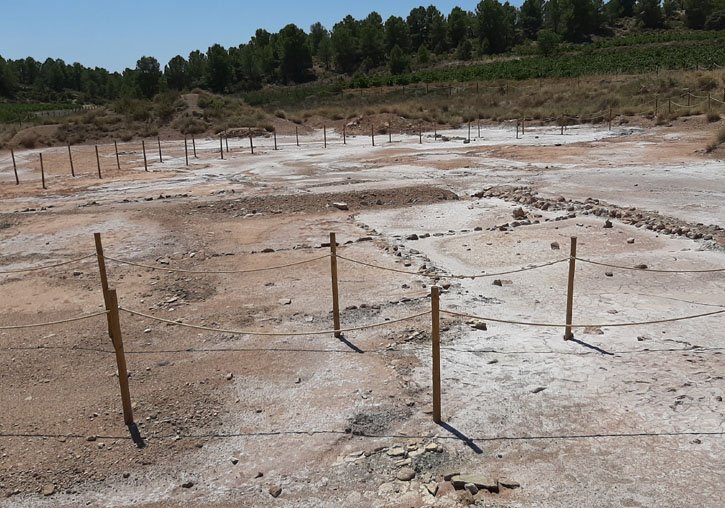The salt trade was a source of Iberian wealth in the Valencian interior
- Scientific Culture and Innovation Unit
- November 13rd, 2020

David Quixal, assistant professor of the Department of Prehistory, Archaeology and Ancient History of the University of Valencia (UV), has shown that the trade and exploitation of the continental salt flats was an important economic activity in the Iberian world in the current Valencian interior. The work compares the analysis of Iberian ceramics recently found in the salt flats and salt mines of Utiel-Requena and La Manchuela Conquense, with the study of the extensive network of roads close to them, the extensive settlement of the area –with the city of Kelin in the centre– and the presence of a type of herd that needed this resource for food.
“In this article we have tried to value a resource, salt, of which we have a marked void of information from Protohistory. We have had the fortune of being able to document Iberian material close to some historic inland salt flats in Requena, spaces exploited for centuries. We are interested in this fact not only to be able to identify the exploitation, but also to be able to insert it within a territorial perspective and understand its role within the settlement pattern and mobility networks during the Iron Age”, stated Quixal.
The study, published in the journal SPAL of the University of Seville, is part of the line of research on the Iberian settlement in the Utiel-Requena region developed by the team of UV professor Consuelo Mata. In it, Iberian ceramics have been studied –among others, the remains of a large cooking pot, three jars, a lid and a pot– found in the Salinas de Jaraguas (Venta del Moro) and Hórtola (Requena). These could be linked to activities such as washing the product, igniting the brine or storing the salt, or simply with the equipment of the Iberian communities installed there.
According to David Quixal, the production of salt would generate important resources for the families that inhabited the territories of Kelin (Caudete de las Fuentes) and Ikalesken (Iniesta, Cuenca), due to its connection with the economy around livestock. In this sense, the finding of a series of pictorial representations of sheep and goats such as the well-known Kelin Gigantomachy Vessel would be in relation to the fact that the presence and exploitation of saline resources favoured the livestock development of the area, as shown by archaeofauna studies. On the other hand, in the Ikalesken territory there would be an important salt mine mentioned by Roman authors as important as Pliny the Elder.
Regarding trade, these salt flats, which also include Los Isidros and Villagordo, would be directly related to traditional roads and fords, essential for the circulation of products and the development of commercial networks. In addition, the area, with hundreds of sites of the time, had a settlement – distribution of inhabited nuclei in a territory – very dense, complex and structured around the central place, the city of Kelin. However, the Iberian salt settlements were probably seasonal due to the need for high ambient temperatures for evaporation, that is, during the summer months.
David Quixal, a specialist in Iberian Archeology, has developed numerous prospecting campaigns for the Iberian and Roman settlements in the Utiel-Requena region and has worked on various excavations in the Spanish and Italian fields, currently being the co-director of the archaeological work in the Iberian settlement from the Pico de los Ajos (Yátova). The present study was developed within the framework of a VALi + D postdoctoral research contract of the Valencian Government (2015-2017) and is inserted in parallel in the research project of the Kelin oppidum and its territory (Museum of Prehistory of Valencia and UV).
Article:
Quixal Santos, D. (2020): “Explotación de la sal, vías de comunicación y territorio durante la Edad del Hierro en el entorno del río Cabriel”, Spal 29.2: 31‑48. DOI: https://dx.doi.org/10.12795/spal.2020.i29.16
Annex photo caption:
David Quixal, PhD Assistant Professor of the Department of Prehistory, Archaeology and Ancient History of the University of Valencia (UV).



















